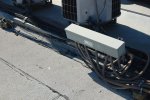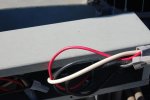stuckinlodi
Member
- Location
- Lodi, Ca, USA



A four story condominium project covering a four city block area has underground parking and many electrical distribution rooms for gangs of meter/mains to each unit. Each unit has indiviual electrical circuit breaker panels of the unit loads and then one circuit from each unit is extended to HVAC condensors on the roof. At the roof I notice that several of the circuits are combined in NEma 3R gutters and two gang bell boxes and not labeled to indicate which unit they originate from or how to disconnect the power. From these boxes and gutters they continue to the condensors some as much at 15 feet away and terminate at non fused disconnects which are labeled with the unit number. I see many problems with combining circuits from differently metered and controlled panels not to mention the lack of labeling. I also see this as a problem and violation of NEC 110-10, where who knows what would happen if two non grounded conductors were to cross due to insulation problems in the combined gutter or junction boxes. Would there be adequate protection for such long conductor lengths from the first floor to the roof and back to a possible other unit on a different floor to trip a breaker or have a melt down? The electrical engineer of record sees no code violation?


